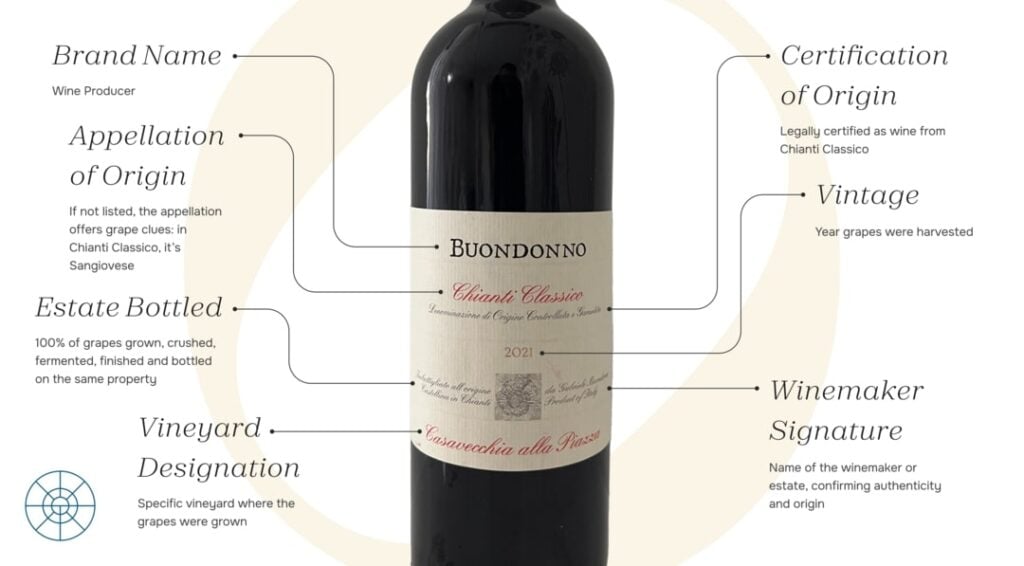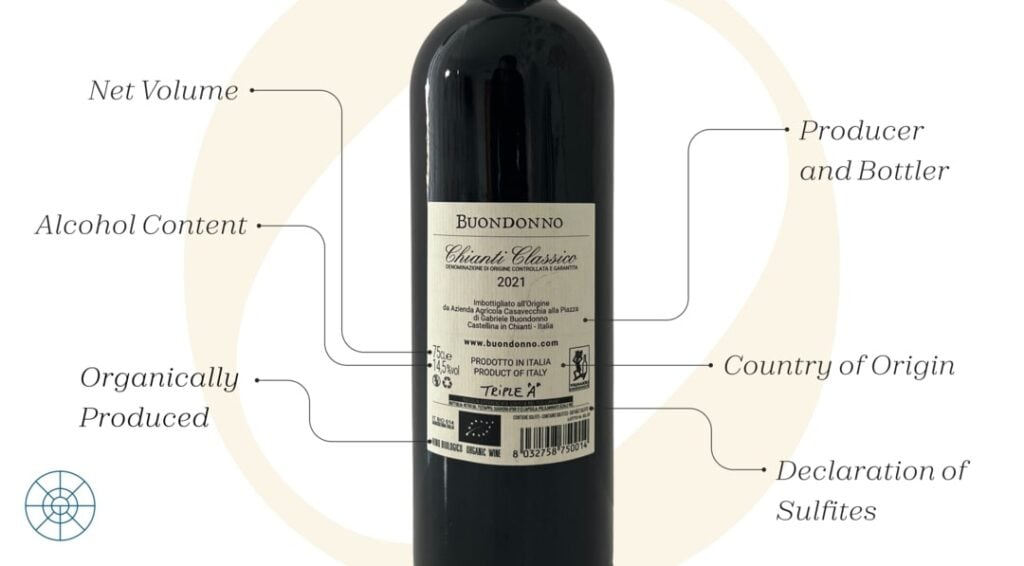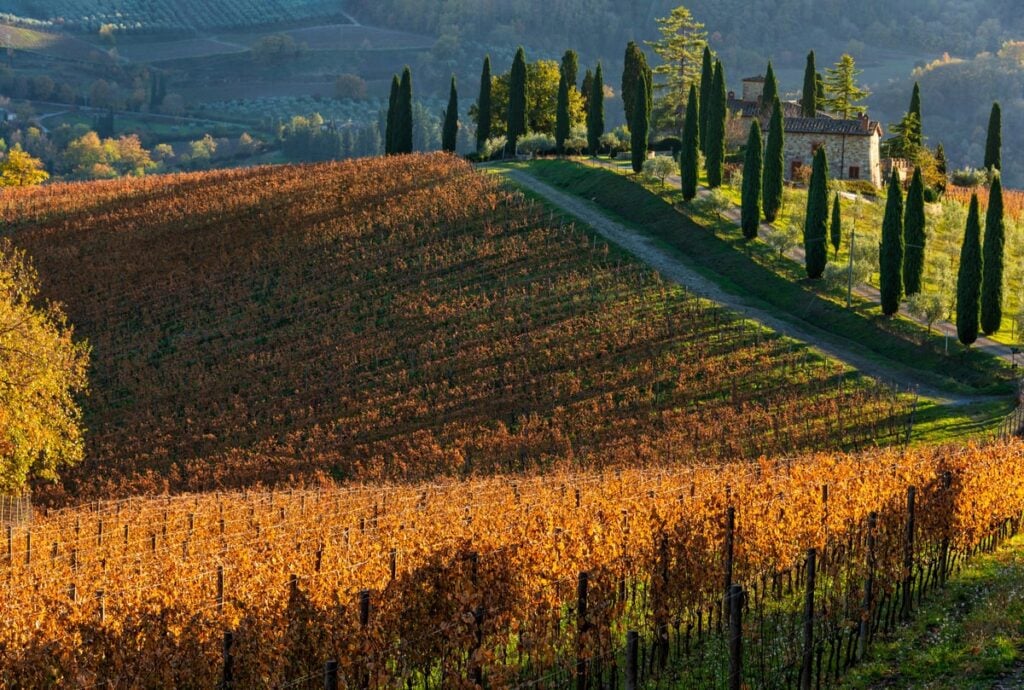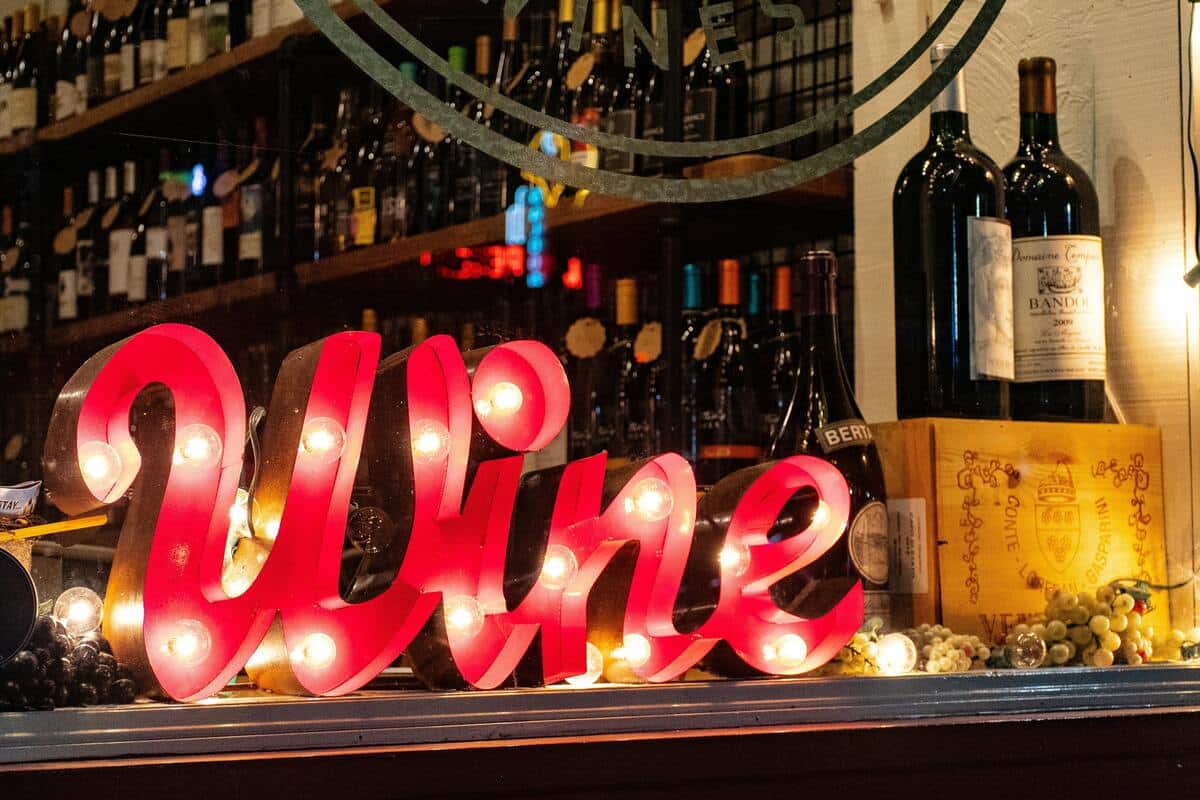Standing in a Tuscan winery, you’ll find yourself surrounded by rows of bottles that seem to whisper promises of tradition and taste. You don’t want the label to stare back at you like some Da Vinci Code riddle—2009, 13%, DOCG—what is it really trying to tell you?
Wine labels aren’t meant to confuse; they’re meant to guide. And we’ll guide you through the basics of understanding how to read wine labels like a seasoned traveler. Because the more you know wine, the more you love wine—and the more you love wine, the more you enjoy life.
Why Learning to Read a Wine Label Matters for Global Travelers
When on a wine journey, every bottle you try makes a direct impact on your final impression and travel experience. If you know how to read a wine label properly, you’re not just nodding along to whatever the tasting room staff or salesperson at the local wine shop suggests, nor grabbing the bottle with the prettiest design. You have confidence in being able to pick something authentic and connected to the region you’re discovering.
Moreover, it keeps you from falling into the “tourist trap” wines that line the shelves in the busiest spots. Instead, you know how to spot the bottles that locals are taking home for dinner. A luxury wine tour is all about turning tastings into deeper experiences, and decoding labels plays a significant part in that.
It’s also a skill that stays with you long after the trip ends. Back home, when you walk into your favorite wine shop, you’ll recognize the regions, grape varieties, and classifications you encountered in your travels. You’ll know how to find a bottle that brings back the Chianti flavors of a Tuscan hillside or the Médoc memories of a quiet afternoon in Bordeaux, because now, you truly understand what the label is saying.
The Anatomy of a Wine Label
Although labels may vary across countries, most of them share some common elements, providing information that tells you exactly what’s inside the bottle. That is, if you know where to look. Think of reading a wine label as looking at its ID: every detail reveals something about its origin and key characteristics.
Front Label Essentials

- Winery Name/Producer: The name at the top (or bottom) often carries the weight of generations. Some labels proudly display a family estate, others a modern winery business. All in all, this indicates the name of the winery or company behind the wine, and more often than not, estate-bottled wine tends to be of higher quality compared to that produced on a larger scale.
- Region/Appellation: This is your geographical anchor—Bordeaux, La Rioja, Napa Valley. It tells you where the grapes grew and thus hints at the flavors and style you can expect. That is why knowing your regions is important. Appellations are even more specific locations within the regions. The quality (and price) of wine tends to be correlated with the more specific location labels over generic ones.
- Grape Variety or Blend: Cabernet Sauvignon? Pinot Noir? Or maybe a blend that never reveals all its secrets. This detail defines what’s in your glass more than anything else. If it’s not on the front, try to find it on the back label.
- Vintage Year: Not just a date, but a snapshot of weather, harvest, and the unique season that shaped the wine. Clearly, a wine from a good year is better than a wine from grapes harvested during a badly timed storm or hail. Moreover, the vintage date indicates how long the wine has been aging in the bottle.
- Classification Terms (DOCG, AOC, AVA): These acronyms can feel cryptic, but they’re just official certifications, regulations, ensuring the wine has been made according to regional standards. They speak volumes about regional winemaking rules and authenticity. More about them later on.
- Alcohol by Volume (ABV): Usually found at the bottom, it tells you the wine’s strength (and additionally, a hint of how lively your tasting might get). ABV typically ranges between 11-15%; white wines are usually a little lower than reds. Legally, they have 0.5% room for accuracy slippage on both sides.
Back Label Insights

Think of the front label as the introduction with essential info, and the back label as where the winery gets a little more talkative. Sometimes it might give you a full guide to what’s in the bottle and how to enjoy it.
- Tasting Notes: These can range from genuine sensory clues (“dark cherries, leather, a hint of oak”) to pure marketing poetry. Separate honest descriptions from empty buzzwords.
Food Pairing Suggestions: While not always essential, these can be a helpful nudge, especially if you’re planning a dinner in a place where the menu is in another language. Our tip is to pair lighter wine with lighter food, and vice versa.
Importer/Distributor Info: A small but telling detail. It helps trace how the bottle reached your hands, especially if you’re buying wine imported from abroad.
Certifications: Look for terms like organic, biodynamic, or sustainable. These marks reflect the winery’s philosophy, farming, and business practices.
Storage & Serving Notes: Occasionally overlooked, but useful, as some wines prefer to rest a little before being poured, or best served at a certain temperature, and these notes tell you just that. - Sulfites: Producers are obligated to tell you if sulfites were used in case they exceed 10mg/litre. This can only be an issue for people with sulfite allergies; other than that, you’re good to drink regardless of sulfite usage.
Decoding Regional Wine Label Styles Across the Globe
If you’ve ever compared a bottle from Tuscany to one from California, you’ve probably noticed they seem to speak different languages. That’s because they do; each wine region has its own storytelling tradition, its own way of saying, “Here’s who I am.” Learning to read those cultural cues makes every wine tasting more rewarding.

Old World Wines (Europe)
The label in Europe goes beyond a list of facts to a map of heritage. Old World wines focus on terroir and appellation, which define where the grapes were grown rather than simply what variety they are. Terms like DOCG in Italy, AOC in France, or DO in Spain are quality seals, protecting the wine’s name and its legacy.
Take Chianti Classico DOCG, for instance. Chianti is the broader region in Tuscany, Classico refers to its historical heartland, and DOCG (Denominazione di Origine Controllata e Garantita – Controlled and Guaranteed Designation of Origin) is Italy’s highest guarantee of authenticity. Once you understand all of this, you’re no longer just buying a bottle; you’re connecting with centuries of craftsmanship.
New World Wines (USA, South Africa, South America)
Cross the ocean again, and you’ll find a different philosophy. New World wines lead with the grape variety (Cabernet Sauvignon, Chardonnay, Shiraz) because the focus here is on expression rather than hewing to tradition. Branding is prominent, and labels are more casual, often highlighting the winery’s story or style over info about its place of origin.
It’s the difference between personality and heritage: New World wines introduce themselves by name, while Old World wines don’t have to, as their place of origin already speaks for them.
Unique Labeling Traditions Worth Knowing
Every winemaking country has its own labeling systems and lingo. In Germany, the Prädikatswein system ranks wines by ripeness level, from Kabinett (light and refreshing) to Spätlese and Auslese (richer, late-harvest wines).
Portugal distinguishes its Ports by age, blend, and style: Ruby for youthful vibrancy, Tawny for mellow nuttiness, and Vintage for the single years.
In Spain, Argentina, and Chile, words like Reserva or Gran Reserva indicate extended barrel aging or higher quality tiers. Some producers might abuse these terms for marketing though, so don’t base your entire purchasing decision around them.
Even within a single country, labeling traditions can vary. In France, for example, a Bordeaux label emphasizes the château (estate) and usually blends several grape varieties, while a Burgundy label highlights the terroir—the exact vineyard (climat) where the grapes were grown—usually from a single grape like Pinot Noir or Chardonnay.
Each of these nuances adds another layer to your wine journey, one that truly comes alive when exploring the world’s best wine destinations.
The Rules and Codes Hidden in Wine Labels
Not all secrets are printed in bold. Some are hidden in the fine print, or not printed at all. Behind every wine label lies a quiet system of rules that ensures authenticity and transparency. You won’t necessarily see these codes, but understanding them helps you read between the lines of every bottle you pick up.
The 75/85/95 Rule Explained Simply
When you’re browsing bottles in the U.S., these numbers are in the background quietly defining what you’re drinking. These are the labeling standards that keep things honest:
- 75% – If a wine says Cabernet Sauvignon, at least 75% of it must come from that grape.
- 85% – If it claims Napa Valley or any other region, at least 85% of the grapes must be sourced there.
- 95% – If a specific vintage year is listed, 95% of the grapes were harvested in that year.
Common Quality Seals and What They Mean
Exploring wine regions across the globe gets you to notice that many bottles carry official seals and acronyms regulated by governments. For a wine from a particular area to be able to use these official appellations, it must be produced according to the specific rules of that appellation. This helps understand quality, authenticity, and the philosophy behind the wine. Let’s finally decode them.
DOC (Denominazione di Origine Controllata – Italy)
This Italian certification guarantees that the wine comes from a specific region and meets strict production rules. Think of it as a local authenticity badge. If you pick a Chianti Classico or Bolgheri in Tuscany, DOC assures you it was made with regional grapes and traditional techniques.
DOCG (Denominazione di Origine Controllata e Garantita – Italy)
DOCG is the next level up from DOC, literally “controlled and guaranteed.” Wines with this seal must pass rigorous tastings and government inspections before they leave the winery, so they are also undoubtedly high quality. It’s Italy’s way of saying, “This bottle represents the pinnacle of regional quality.”
AOC (Appellation d’Origine Contrôlée – France)
The French version of DOC, AOC assures you that the wine’s grapes come from a specific area and that production follows unique appellation rules. When you sip a Saint-Emilion or Médoc in Bordeaux, you’re tasting centuries of carefully protected tradition guaranteed by AOC.
DO (Denominación de Origen – Spain & Portugal)
Spain and Portugal also have their own version of regional authenticity. DO indicates that the wine comes from a recognized area and follows local winemaking standards. Gran Reserva or Reserva labels within a DO further signal extended aging or higher quality wines.
AVA (American Viticultural Area – U.S.)
On the other hand, across the Atlantic, the U.S. uses AVA to define grape-growing regions. While not as strict on production methods as Europe, an AVA tells you where the grapes were grown, which heavily influences flavor. A Napa Valley AVA Cabernet promises sunny Californian notes in your glass.
Organic, Biodynamic, and Sustainable Certifications
Beyond geographical seals, some bottles carry marks reflecting how the grapes were grown:
- Organic – Grapes are cultivated without synthetic pesticides or fertilizers.
- Biodynamic – Goes a step further, following holistic farming methods based on natural cycles.
- Sustainable – Environmentally friendly practices, from vineyard to bottle, balancing ecology, economy, and community.
These speak not to old rules, but to new values; how the grapes were grown, how the land was treated, and what kind of future the winery is investing in. For the global traveler, these seals tell another story: not just where your wine comes from, but what it stands for.
How to Tell Good Wine from a Label Alone
- Check the region or appellation: Reputable regions like Bordeaux, Barolo, or Napa Valley indicate strict production standards and often higher quality.
- Look for specific vineyards or single-vineyard designations: Bottles highlighting a single vineyard usually reflect more care and unique characteristics.
- Consider the alcohol percentage: Balanced ABV hints at a well-crafted wine; extremely high or low numbers can indicate ripeness issues.
- Distinguish authentic seals from marketing buzzwords: Certifications like DOCG, AOC, or organic/biodynamic marks show oversight and standards, unlike vague terms like “reserve” without context.
- Watch for red flags: Overly generic names, vague origins, or labels emphasizing style over substance can signal a lower-quality or mass-market wine.
Practical Tips for Global Wine Travelers

- Cross-check vintage charts for your travel region: Knowing the best vintages before you visit a region can help you select bottles that truly reflect local quality. Moreover, plan your destinations around your personal wine taste.
- Pair food and wine using label hints: Labels often suggest the ideal pairings for the wine. Use this guidance to enhance your meals, and our guidance for tips on planning your full experience, including attire for luxury wine tours.
- Use QR codes and tech tools to supplement label reading: Many modern bottles now include QR codes or app integrations that provide tasting notes, vineyard stories, and production details. These tools are especially useful when traveling in regions where language barriers might make label reading more challenging.
- Let labels guide cellar storage decisions: If you’re bringing bottles home, labels can inform how long a wine can age or the best storage conditions. Pay attention to vintage, classification, and storage instructions to protect your finds until they’re ready to enjoy.
FAQs About Reading a Wine Label
What is the 75/85/95 rule for wine?
The 75/85/95 rule helps you understand what percentage of grapes in a U.S. bottle must come from a specific source: at least 75% from the stated grape variety, 85% from the listed region, and 95% from the vintage year noted on the label. It’s a quiet system that ensures honesty in labeling.
How to tell good wine from a label?
Look for clues on the label that suggest quality: a reputable region or appellation, a specific vineyard or single-vineyard designation, a balanced alcohol percentage, and authentic certifications like DOCG, AOC, or organic seals. Red flags include vague origins or overly generic names.
What does DOCG mean on wine?
DOCG stands for Denominazione di Origine Controllata e Garantita (Controlled and Guaranteed Denomination of Origin). It’s Italy’s highest quality seal, guaranteeing that the wine meets strict production rules, passes government inspections, and comes from a region recognized for making high quality wine. A DOCG label ensures you’re tasting authentic Italian craftsmanship.
What are the 4 V’s of wine?
The 4 V’s make it easy for travelers to decode a bottle:
- Vintage – The year the grapes were harvested.
- Variety – The grape(s) used.
- Vineyard – The exact vineyard or estate where grapes were grown.
- Vintner – The winemaker or winery behind the bottle.
How to tell if wine is high quality?
High-quality wines come from reputable regions, highlight single vineyards, have balanced ABV, carry authentic seals, and avoid marketing fluff. Labels that provide clear information about origin, grape, and vintage are usually more trustworthy than vague or overly flashy designs.
Final Sip: Reading Wine Labels with Confidence
Reading a wine label isn’t just about facts and numbers, but about storytelling. Every label tells you where the grapes were grown, what variety they are, and hints at the traditions that shaped the wine. With a little knowledge, travelers can decode these stories and connect more deeply with each bottle they encounter.
Next time you’re on a wine tour or in your local wine shop, let your label-reading skills guide your choices. You’ll taste the history of the region and the care that went into the bottle, and that’s what turns every sip into a rich, memorable experience.
Ready to take your label knowledge to the vineyards themselves? Explore Oenotated Travel’s private wine tours and schedule your journey of discovery.

